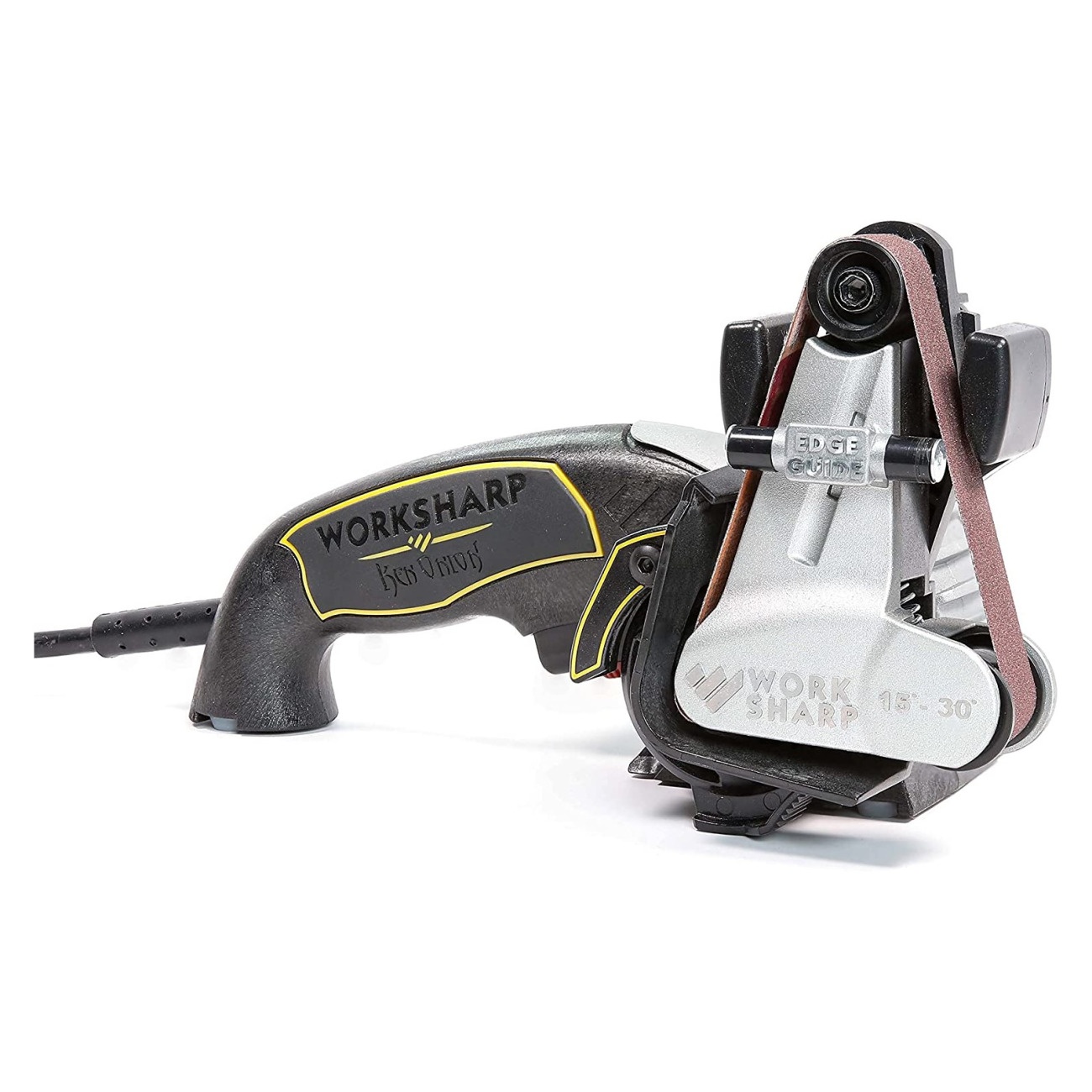Work Sharp Ken Onion Edition
Highlights
Galleries
In the box
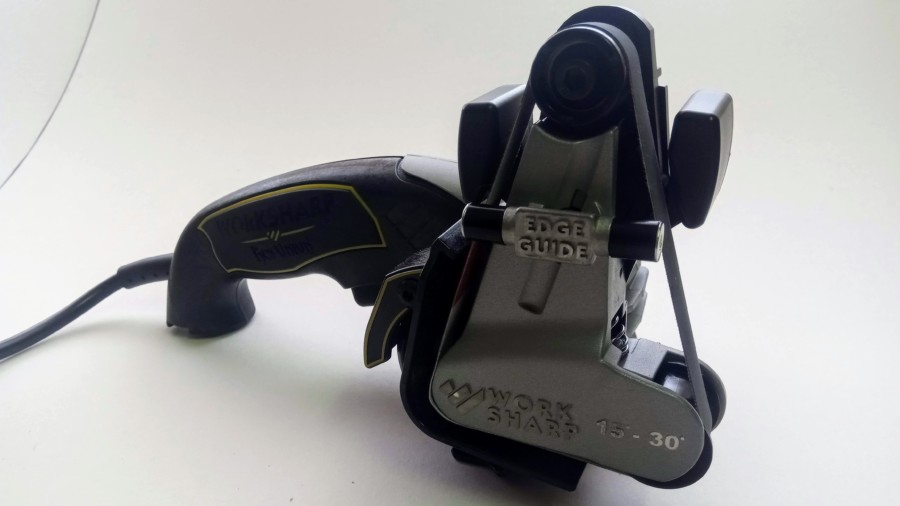 freshly unboxed work sharp ken onion edition
freshly unboxed work sharp ken onion edition the work sharp ken onion edition box opened
the work sharp ken onion edition box opened the rear of the work sharp ken onion edition box
the rear of the work sharp ken onion edition box the other side of the work sharp ken onion edition box
the other side of the work sharp ken onion edition box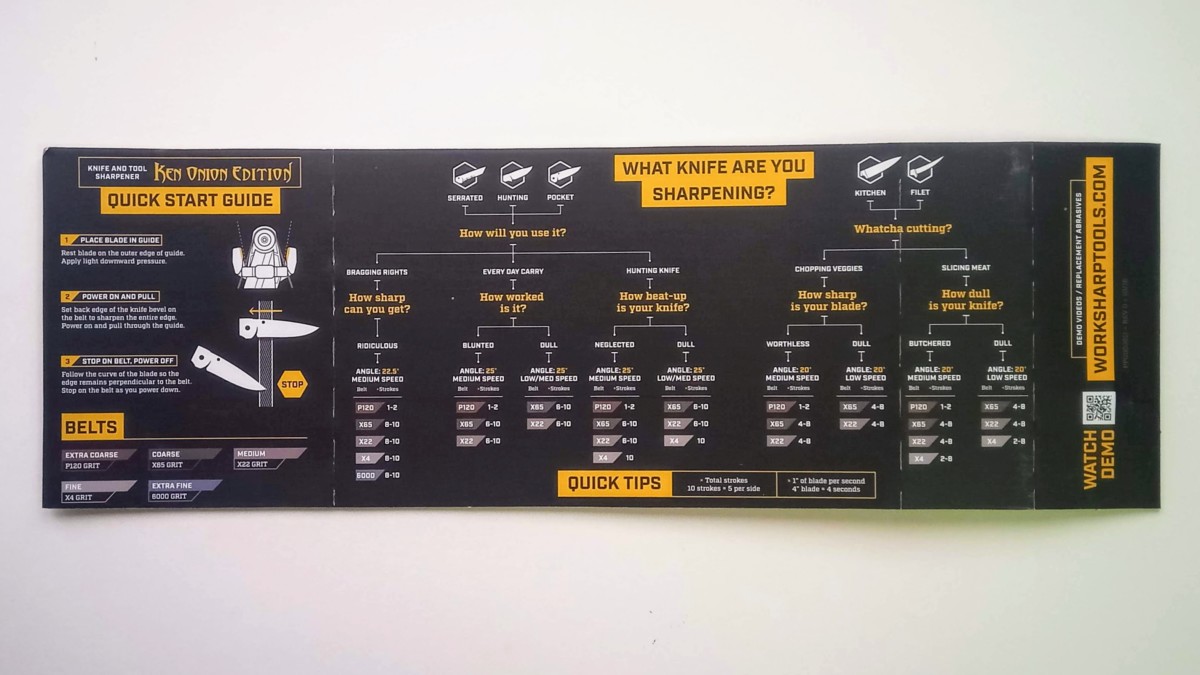 the handy work sharp ken onion quick start guide that comes with the box
the handy work sharp ken onion quick start guide that comes with the box the front of the work sharp ken onion edition box at an angle
the front of the work sharp ken onion edition box at an angle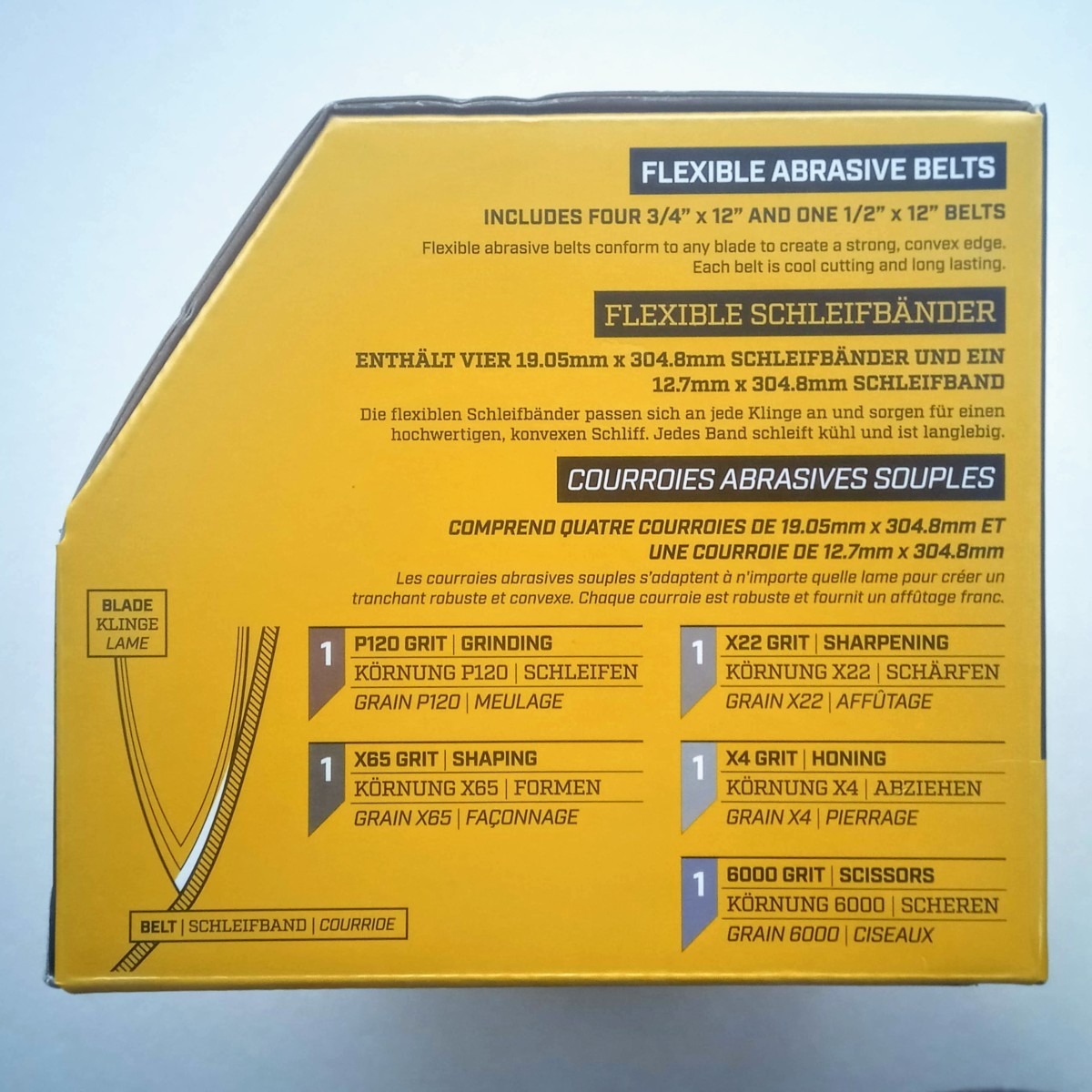 one side of the work sharp ken onion edition box
one side of the work sharp ken onion edition box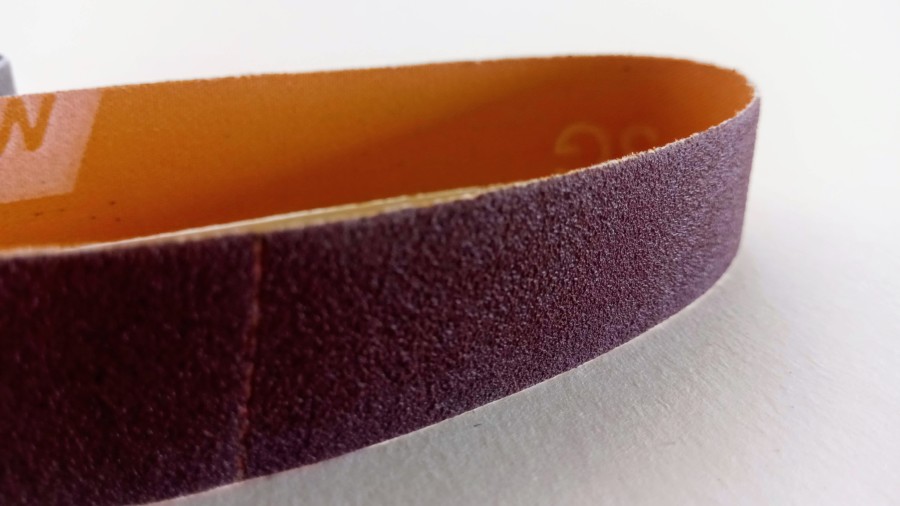 work sharp ken onion p120 abrasive belt for blade repair
work sharp ken onion p120 abrasive belt for blade repair work sharp ken onion x65 (p220) abrasive belt for shaping
work sharp ken onion x65 (p220) abrasive belt for shaping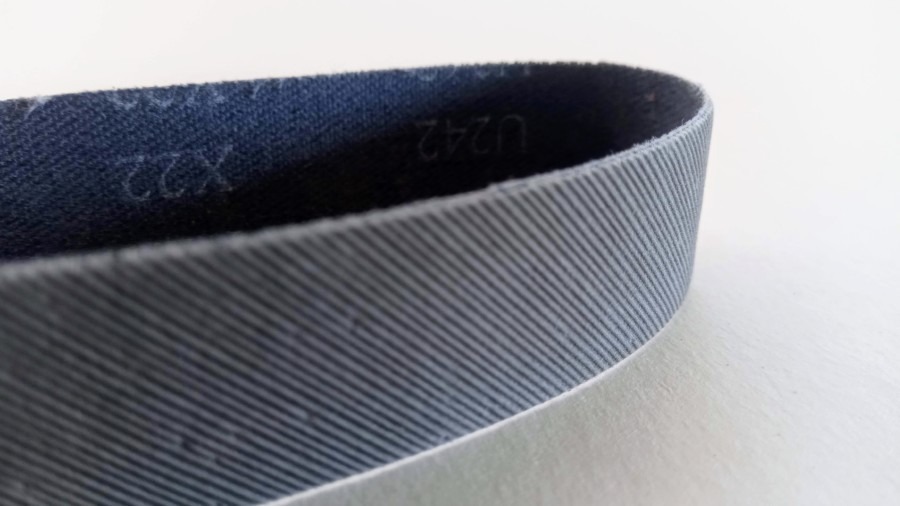 work sharp ken onion x22 (p1000) abrasive belt for sharpening
work sharp ken onion x22 (p1000) abrasive belt for sharpening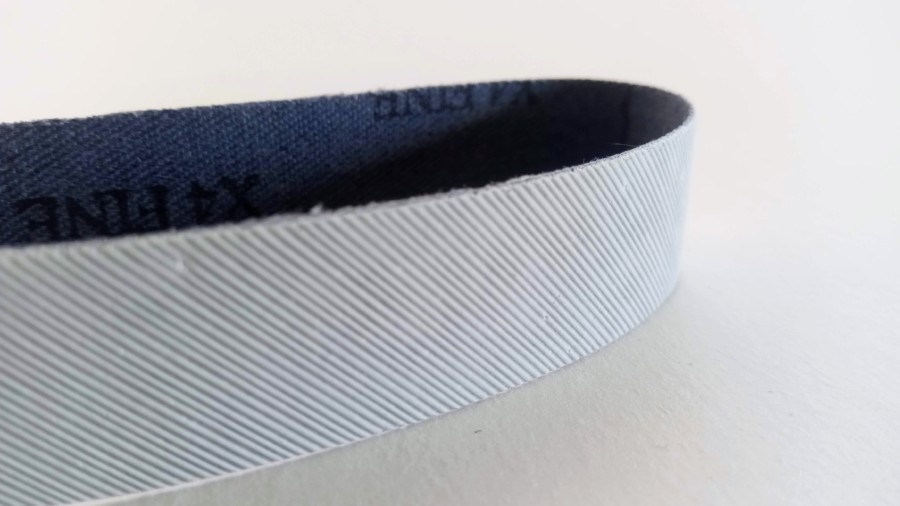 work sharp ken onion x4 (p3000) abrasive belt for honing
work sharp ken onion x4 (p3000) abrasive belt for honing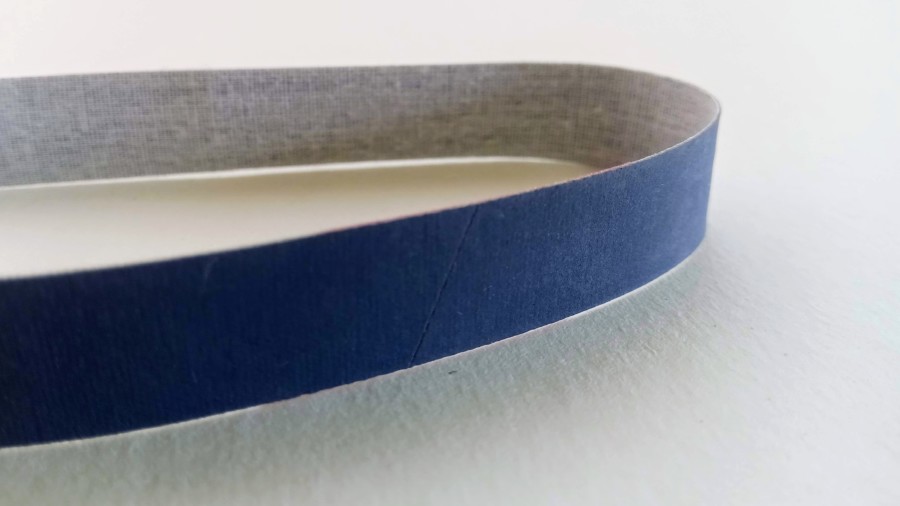 work sharp ken onion 6000 abrasive belt for stropping
work sharp ken onion 6000 abrasive belt for stroppingHow to switch it on
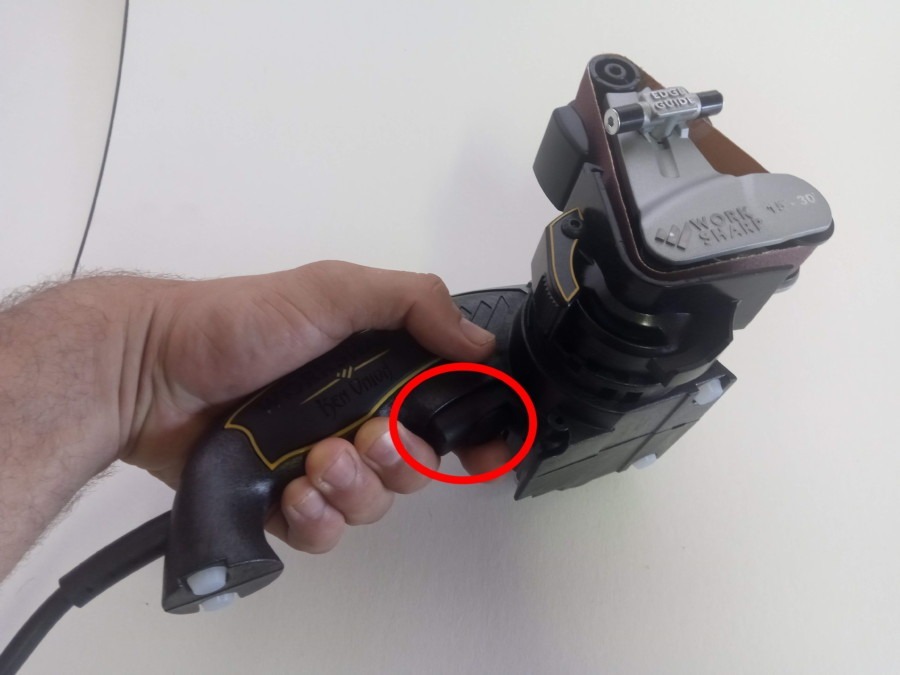 the power switch (with variable speed knob) sits underneath the handle. press this to get the machine going
the power switch (with variable speed knob) sits underneath the handle. press this to get the machine goingLeft or right hand?
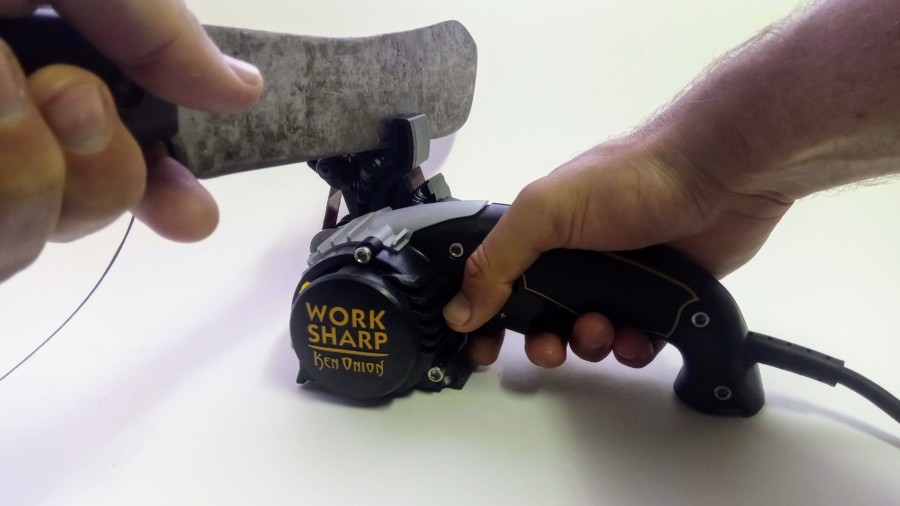 the wrong way to sharpen the left side of a blade
the wrong way to sharpen the left side of a blade the wrong way to sharpen the right side of a blade
the wrong way to sharpen the right side of a blade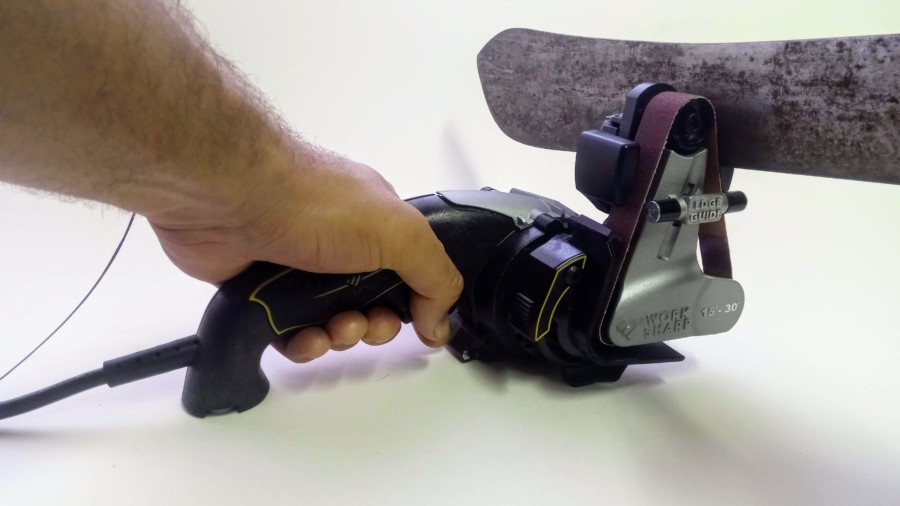 the right way to sharpen the left side of a blade
the right way to sharpen the left side of a blade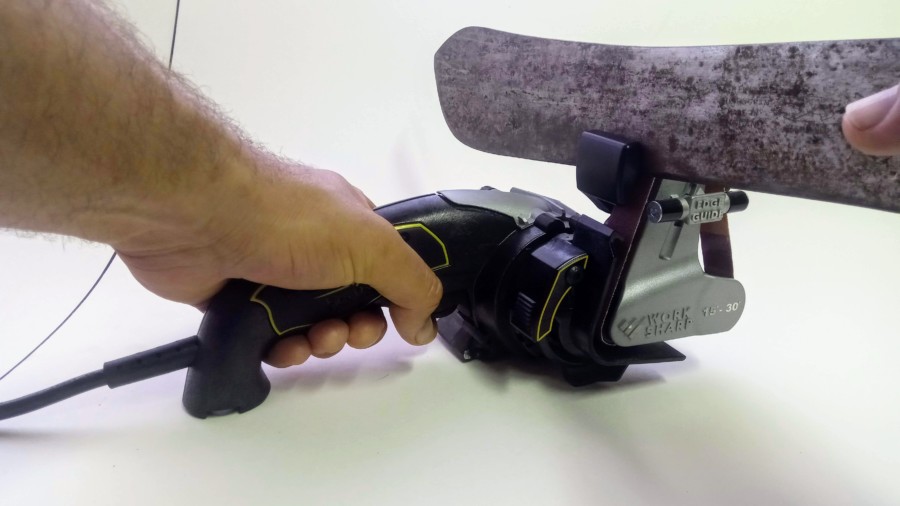 the right way to sharpen the right side of a blade
the right way to sharpen the right side of a bladeRemoving a belt
 fip edge guide to up position
fip edge guide to up position push the spring loaded belt change lever up
push the spring loaded belt change lever up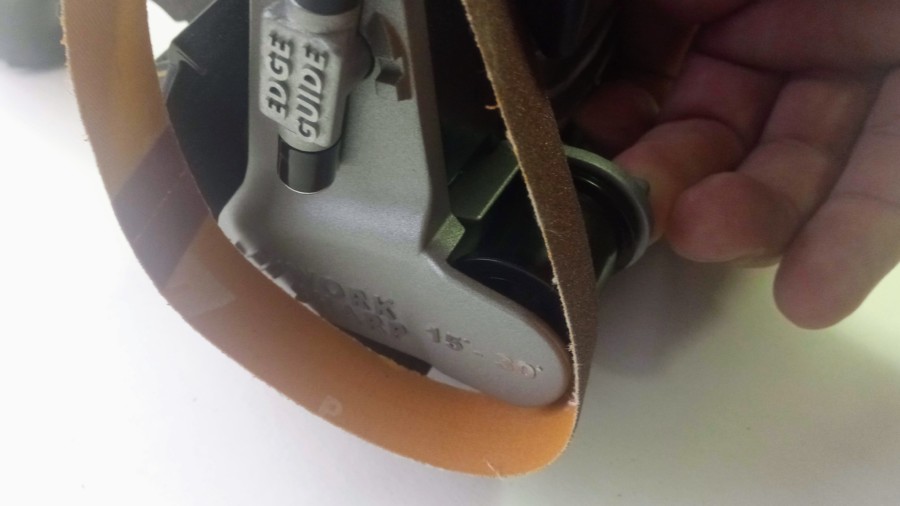 with the belt change lever in the up position, remove the abrasive belt
with the belt change lever in the up position, remove the abrasive beltMounting a belt
 push the spring loaded belt change lever up
push the spring loaded belt change lever up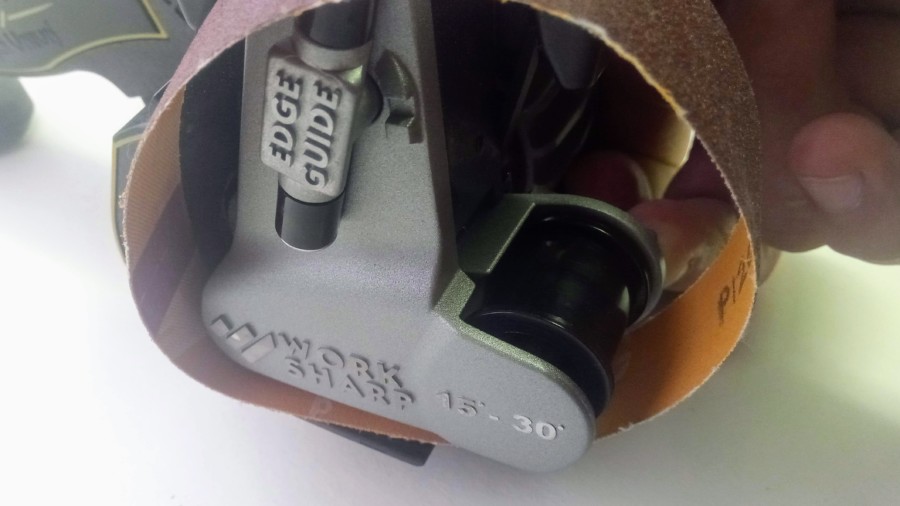 slide the belt onto the two bottom pulleys
slide the belt onto the two bottom pulleys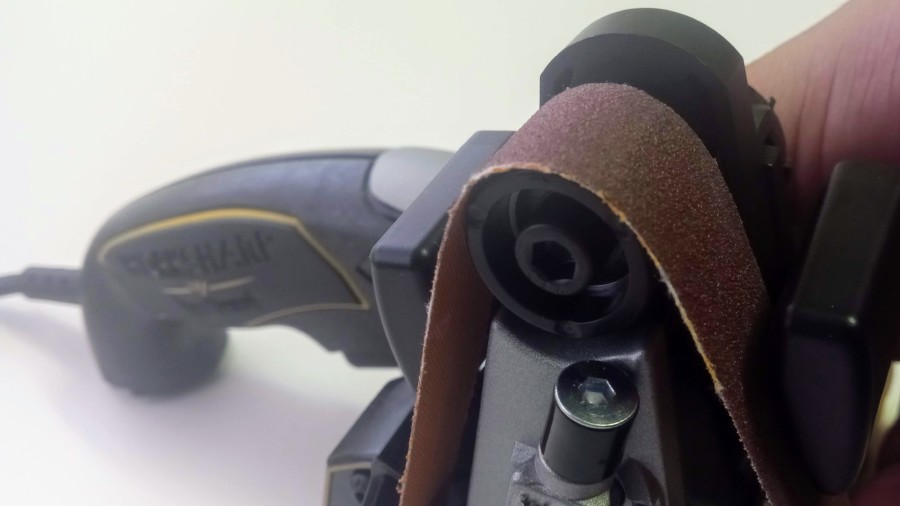 slide the belt over the top pulley
slide the belt over the top pulleySharpening tests
 most of the edges i ran through the work sharp ken onion edition
most of the edges i ran through the work sharp ken onion edition the victorinox swiss army knife i sharpened for a friend
the victorinox swiss army knife i sharpened for a friend bumps visible along the edge of the large blade
bumps visible along the edge of the large blade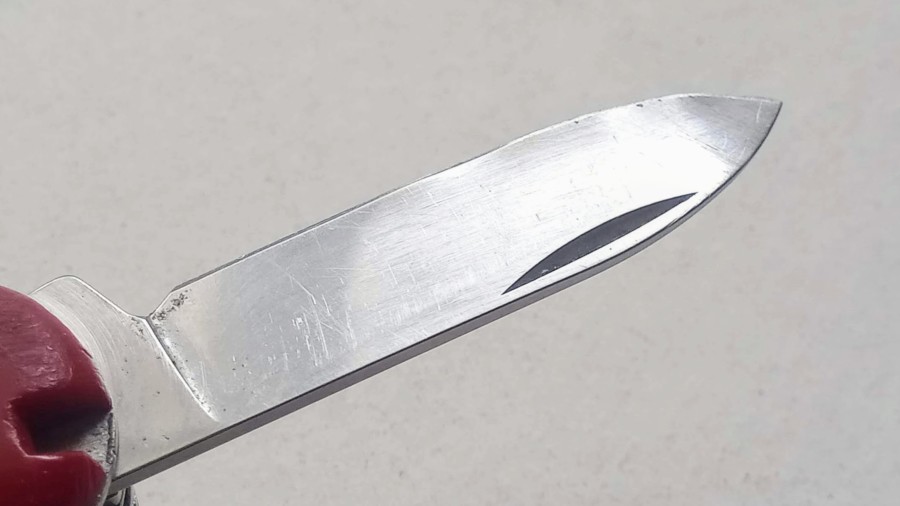 bumps visible along the edge of the small blade
bumps visible along the edge of the small blade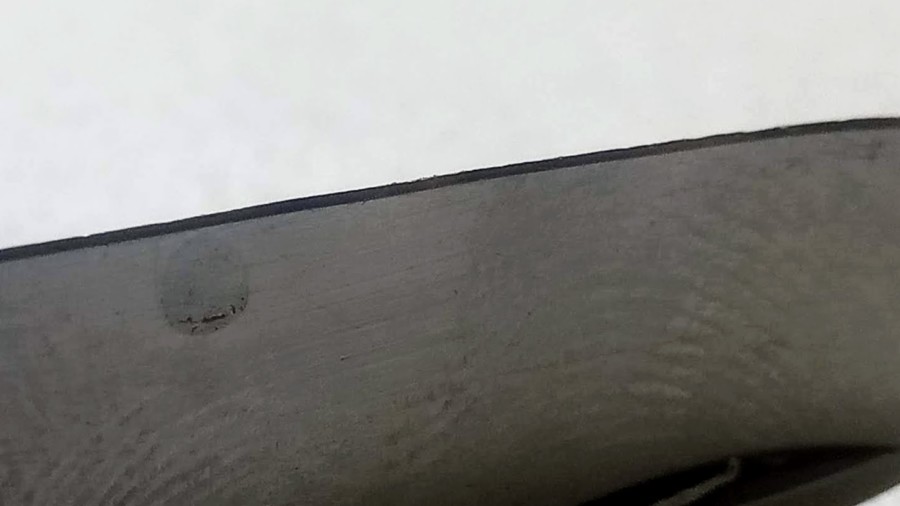 one side of the large blade of the victorinox
one side of the large blade of the victorinox the other side of the large blade of the victorinox
the other side of the large blade of the victorinox one side of the small blade of the victorinox
one side of the small blade of the victorinox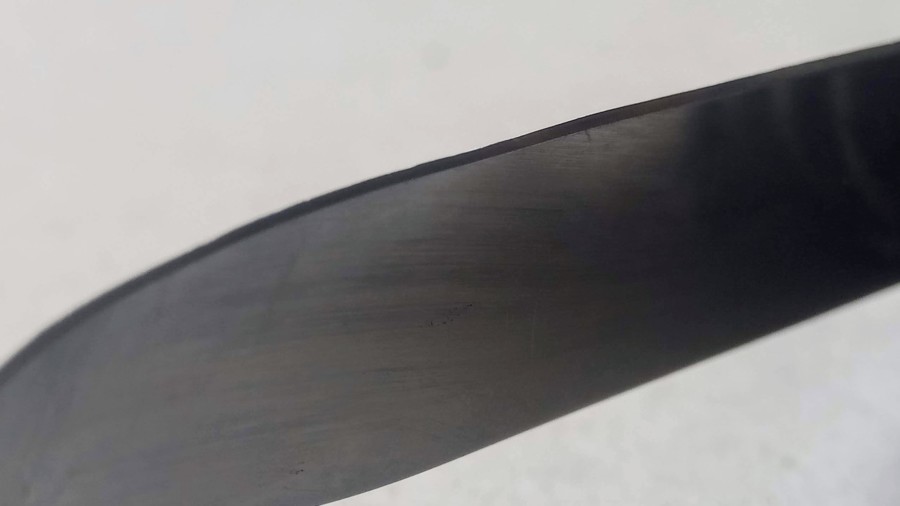 the other side of the small blade of the victorinox
the other side of the small blade of the victorinox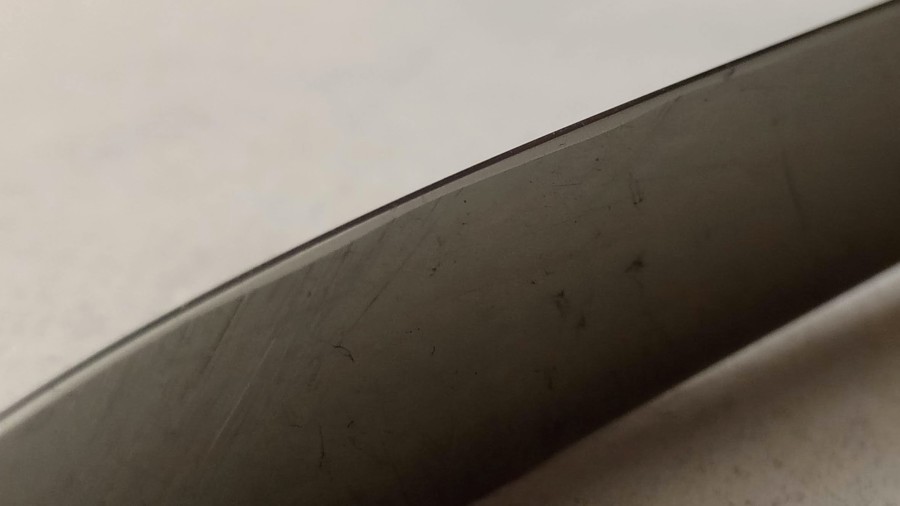 one side of the large blade of the victorinox, after sharpening
one side of the large blade of the victorinox, after sharpening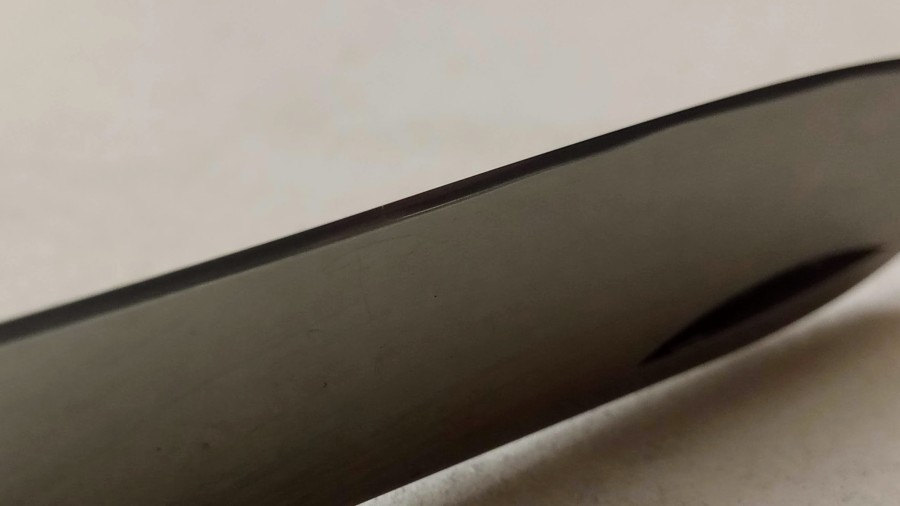 the other side of the large blade of the victorinox, after sharpening
the other side of the large blade of the victorinox, after sharpening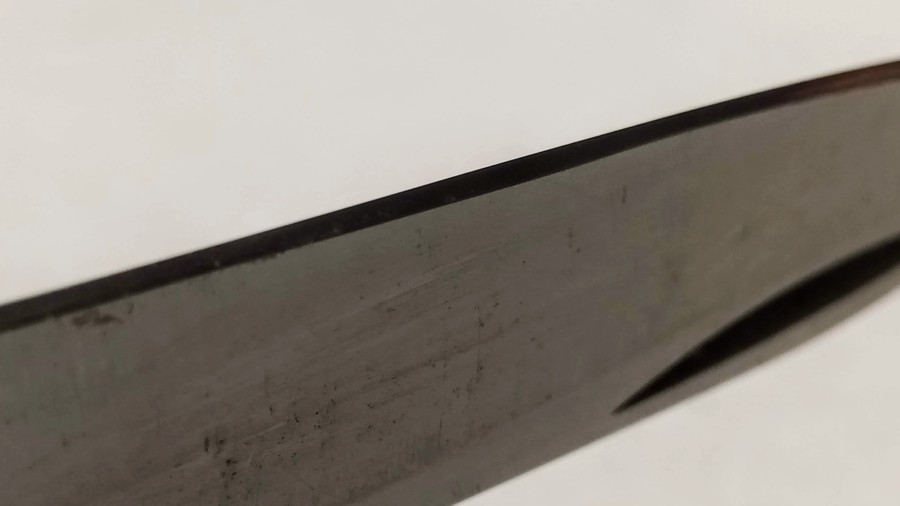 one side of the small blade of the victorinox, after sharpening
one side of the small blade of the victorinox, after sharpening the other side of the small blade of the victorinox, after sharpening
the other side of the small blade of the victorinox, after sharpeningWorking around the bulky body
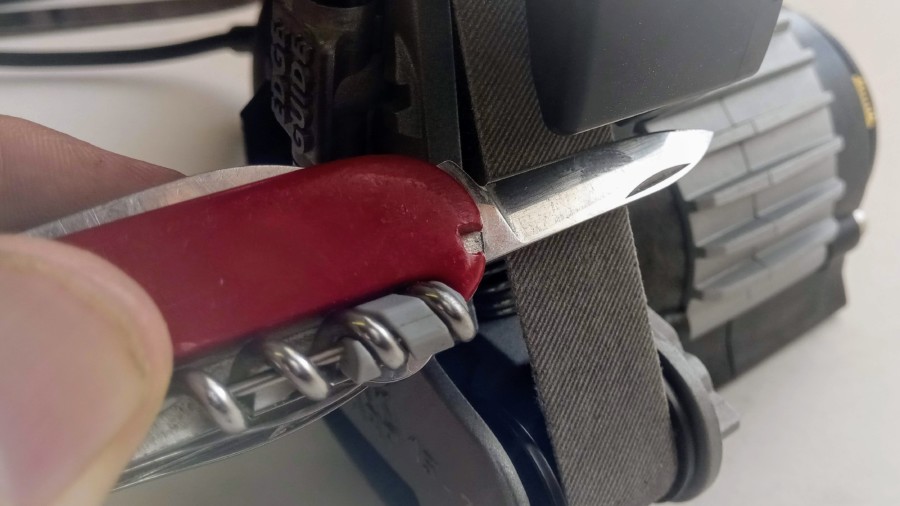 the bulky body of the victorinox swiss army knife necessitated a change in the way i sharpened the right hand side
the bulky body of the victorinox swiss army knife necessitated a change in the way i sharpened the right hand side chef's knife used in sharpening tests for the work sharp ken onion edition
chef's knife used in sharpening tests for the work sharp ken onion edition the chef's knife's edge before sharpening
the chef's knife's edge before sharpening the chef's knife's edge after sharpening
the chef's knife's edge after sharpeningSharpening serrated knife and scissors
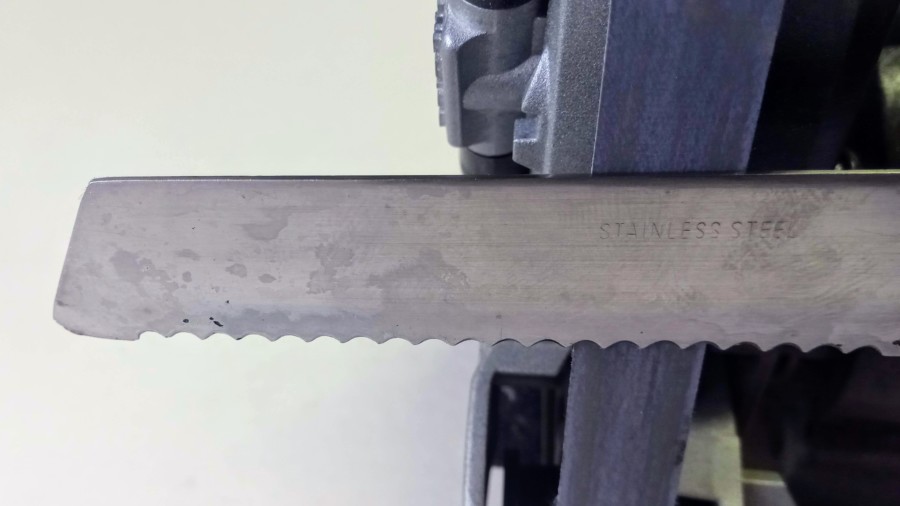 this serrated knife's bevel is on the left hand side, which means i had to use the machine the wrong way around to sharpen the flat side
this serrated knife's bevel is on the left hand side, which means i had to use the machine the wrong way around to sharpen the flat side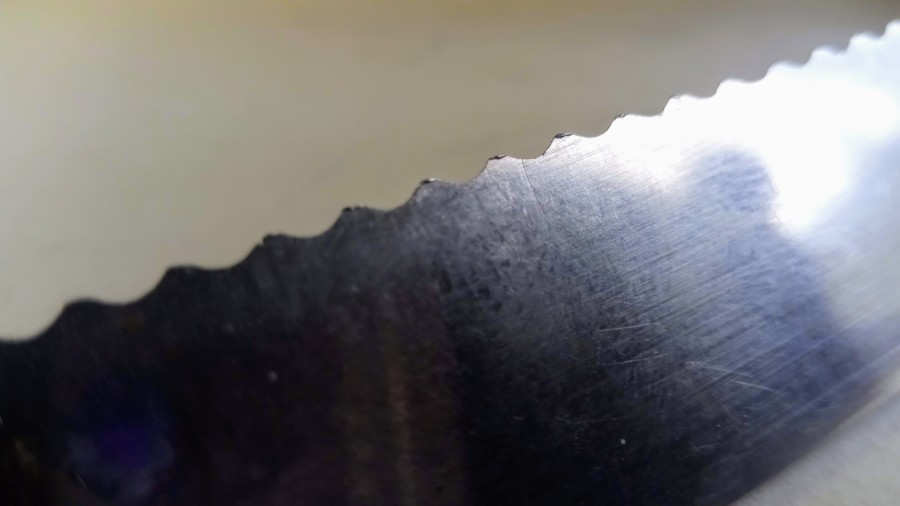 the serrated knife’s edge before sharpening
the serrated knife’s edge before sharpening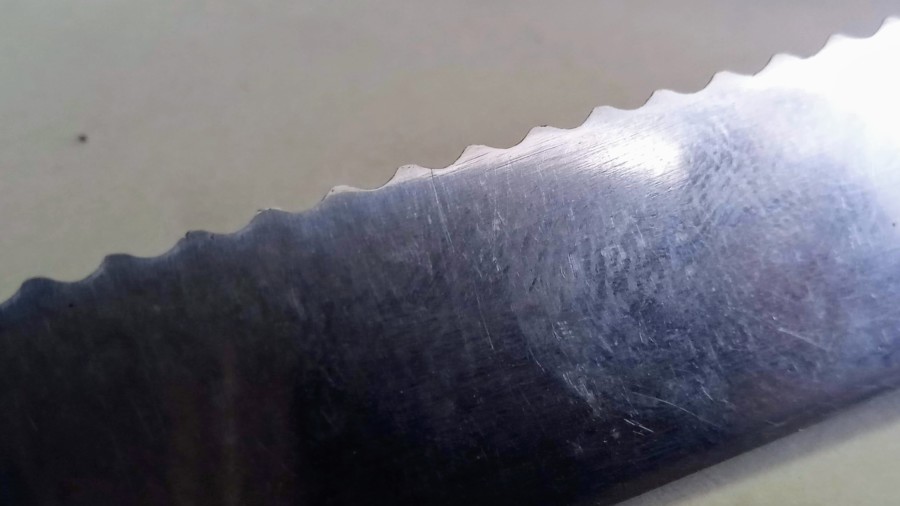 the serrated knife’s edge after sharpening
the serrated knife’s edge after sharpening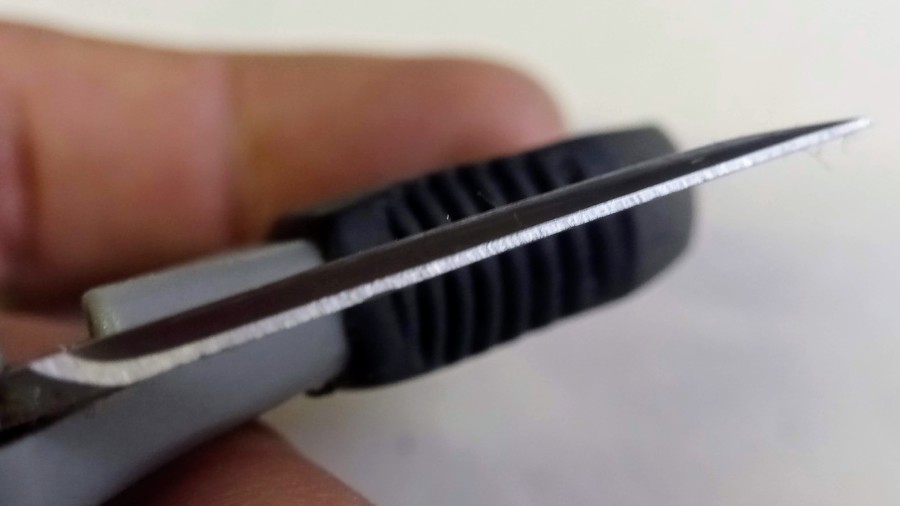 scissors edge before sharpening
scissors edge before sharpening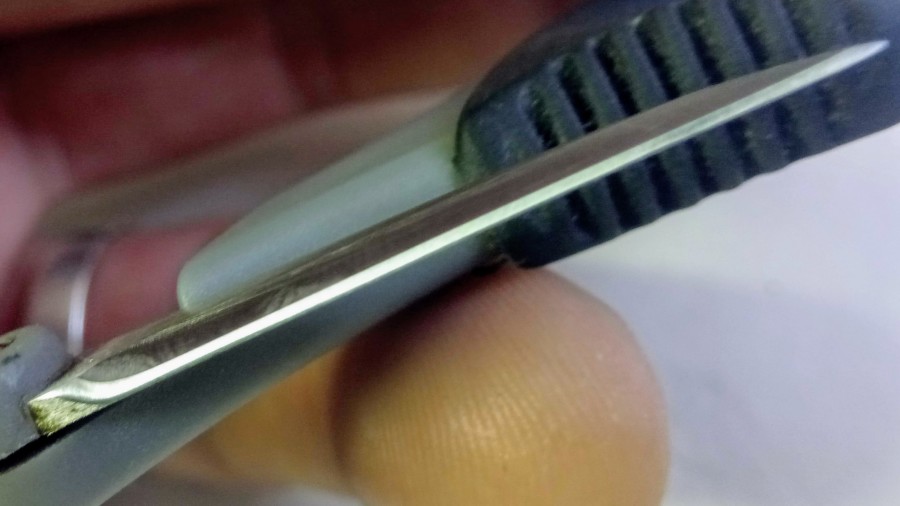 scissors edge after sharpening
scissors edge after sharpeningSharpening other blades
 one side of the ax before sharpening
one side of the ax before sharpening the other side of the ax before sharpening
the other side of the ax before sharpening one side of the ax after sharpening
one side of the ax after sharpening the other side of the ax after sharpening
the other side of the ax after sharpening my friend's machete
my friend's machete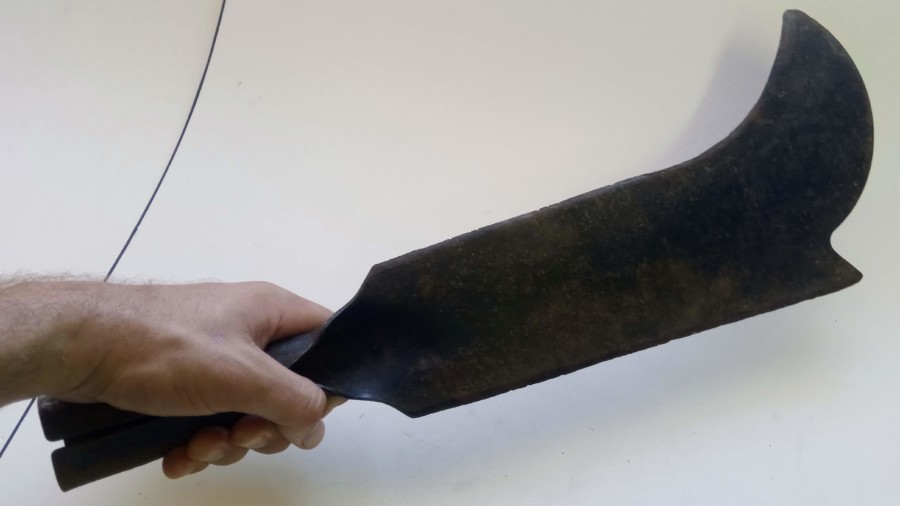 my machete (an african panga)
my machete (an african panga)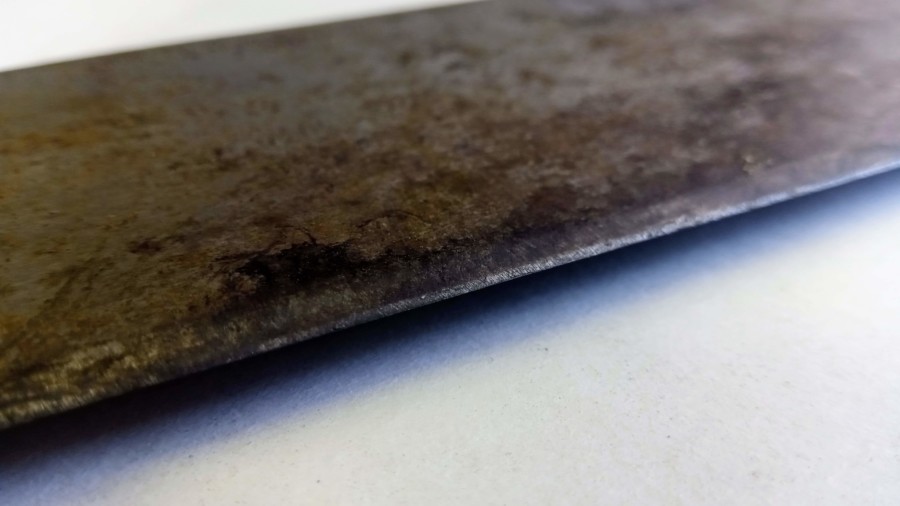 one side of my friend's machete before sharpening
one side of my friend's machete before sharpening the other side of my friend's machete before sharpening
the other side of my friend's machete before sharpening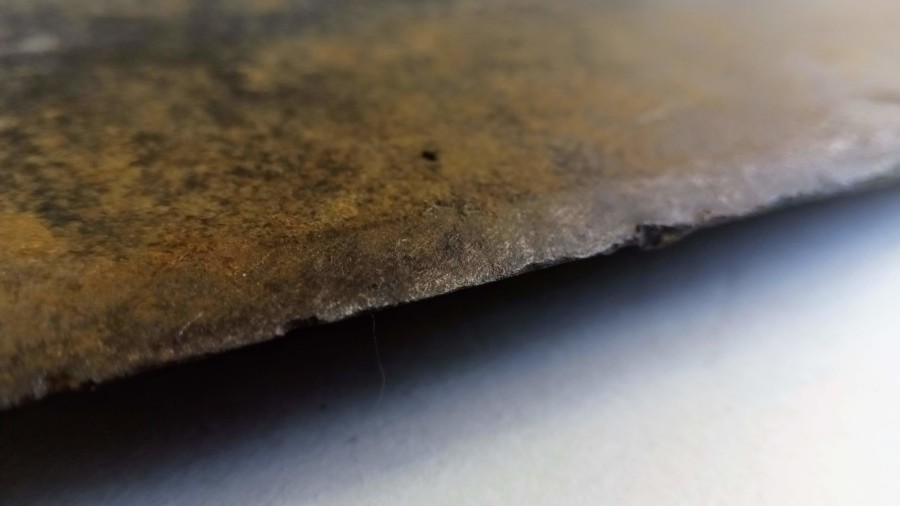 one side of my machete before sharpening
one side of my machete before sharpening the other side of my machete before sharpening
the other side of my machete before sharpening one side of my friend’s machete after sharpening
one side of my friend’s machete after sharpening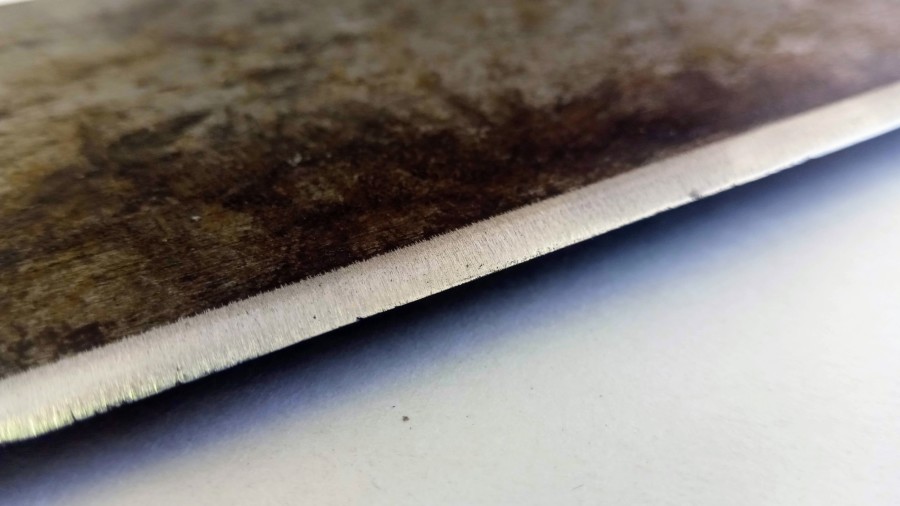 the other side of my friend’s machete after sharpening
the other side of my friend’s machete after sharpening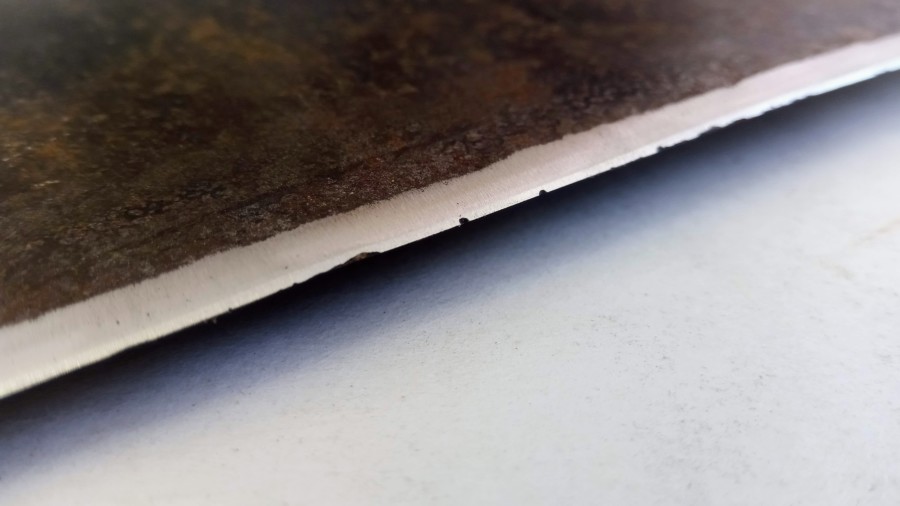 one side of my machete after sharpening
one side of my machete after sharpening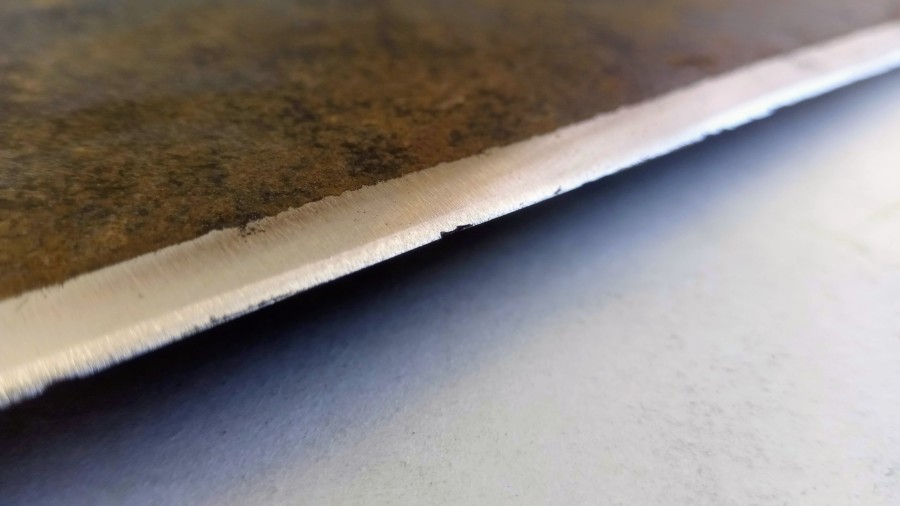 the other side of my machete after sharpening
the other side of my machete after sharpening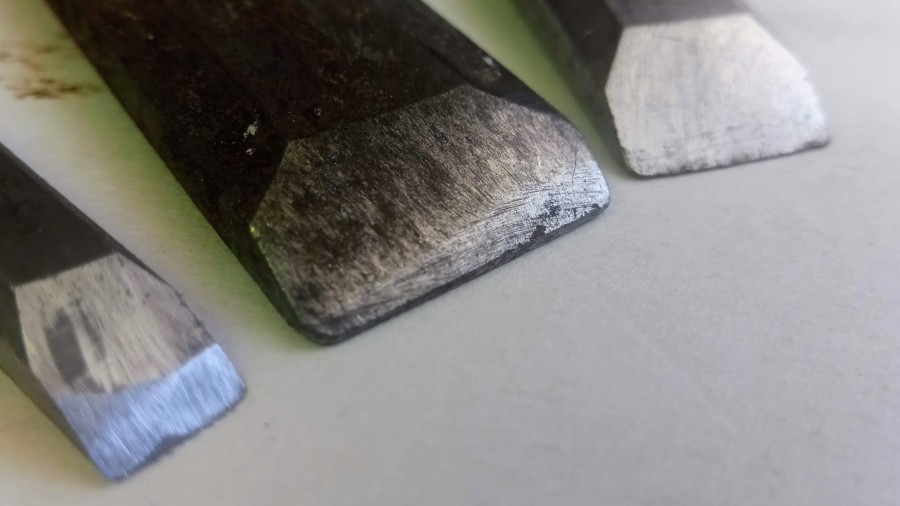 set of chisels before sharpening
set of chisels before sharpening set of chisels after sharpening
set of chisels after sharpening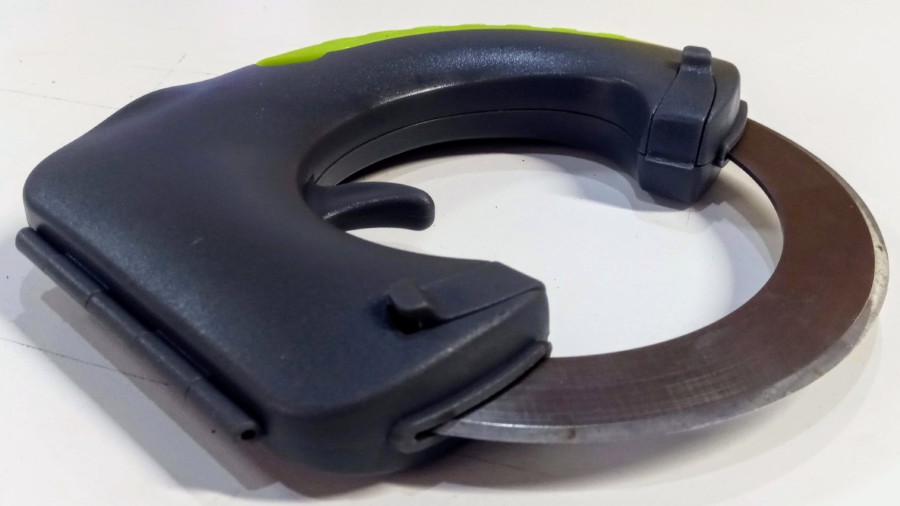 circular knife
circular knife the circular blade removed from the body
the circular blade removed from the body circular blade after sharpening
circular blade after sharpeningTL;DR
The Work Sharp Ken Onion Edition is a phenomenal blade sharpener.
You can use it to sharpen all sorts of kitchen knives (including circular blades found in pizza cutters), axes, machetes, or scissors.
It works fast and cleanly and provides an excellent edge.
Work Sharp put plenty of effort into making knife sharpening easy to understand and do. That’s clear from the super handy quick-start guide that comes with the tool. If you use this guide you’ll create razor-sharp edges, time after time, quickly and efficiently, without burning your blades.
Everything (except maybe the chisels) I chucked at this sharpener, it handled with grace and ease.
I highly recommend the Work Sharp Ken Onion Edition.
Who is it for?
The Work Sharp Ken Onion is for anybody who’s sick of working with blunt blades.
Are you a housewife wondering why time in the kitchen sucks the life out of you? You might think it silly, but a knife with a dull edge plays a big role in draining your energy.
Are you a hobbyist knife maker wanting to sharpen your new creations accurately without going on a 10-year sharpening course? This is the tool for you.
Do you offer edge sharpening as a service to the community? The Ken Onion Edition will come in handy. Work Sharp says it’s not made for industrial use but we don’t follow all the rules, do we? In fact, I’ve started a sideline business sharpening edges for the community.
It’s a great tool for all skill levels.
In the box
The Work Sharp Ken Onion box comes with the following:
- 1 x Work Sharp Ken Onion knife & tool sharpener.
- 5 x abrasive belts.
- 1 x P120 grit for grinding.
- 1 x X65 (P220) grit for shaping.
- 1 x X22 (P1000) grit for sharpening.
- 1 x X4 (P3000) grit for honing.
- 1 x 6000 grit for scissors and stropping.
- 1 x user’s guide.
- 1 x quick start guide.
Freshly Unboxed Work Sharp Ken Onion Edition.
How to switch it on
Make sure your Work Sharp is plugged into a wall outlet and the machine is standing comfortably on a stable platform, like a table.
Then simply press the power switch.
The Power Switch (with Variable Speed Knob) Sits Underneath The Handle. Press This To Get The Machine Going.
How to adjust the speed
The Ken Onion Edition comes with a variable speed setting.
The variable speed dial is located in the power switch, making it easy to adjust the speed with two fingers.
Left or right hand?
Both the standard Knife & Tool Sharpener and the Ken Onion Edition are for use with the object you’re sharpening in your right hand if you’re using it in the standard fashion.
There are exceptions, like when you sharpen a serrated knife, which requires you to only sharpen one side. If the serrations are on the “wrong” side, use the machine the “wrong” way around.
The wrong way around
The right way around
How to remove and insert a belt
It takes a little bit of getting used to, getting the belt off and on, but it’s not difficult. It was just my fat fingers were not used to doing it at the beginning. The more you do it the quicker it goes.
Removing a belt
Follow these 3 easy steps to remove a belt:
- Place the edge guide in the up position (optional).
- Push the spring-loaded belt change lever up.
- With the belt change lever in the up position, remove the abrasive belt.
Mounting a belt
Follow 3 easy steps to mount a belt:
- Push the spring-loaded belt change lever up.
- Slide the belt onto the two bottom pulleys (one of which is mounted to the belt change lever).
- Slide the belt over the top pulley.
How to sharpen a knife
Sharpening a knife with the Ken Onion is simple.
For the purpose of this section, I’m sharpening a smooth-edged steak knife.
This section is simply to show the basic use of the machine. I’ve not set up the speed of the machine according to Work Sharp’s guide.
See further below for actual sharpening tests.
Here are some rules of thumb:
- For sharpening axes and tools, use the coarse belt (P120) at the highest speed.
- For honing blades, use the smoothest belt (6000) at the lowest speed.
- Rest the blade on the belt before starting the machine.
- Turn off the machine before lifting the blade from the belt.
- Don’t sharpen the bevel side of a serrated knife.
- The recommended feed speed for sharpening a blade is 1in/second (25.4mm/s).
The wrong way to sharpen a knife
- Only switch on the machine once the blade is in place inside the guide slot.
- Never pull a blade all the way past the abrasive belt. This can cause the point to round.
The right way to sharpen a knife
- BEFORE you run the motor, place your knife into the guide slot, onto the edge guide, resting the cheek of your blade against the outer guide.
- Start the motor and pull the knife all the way back.
- DO NOT apply much pressure. You’re supposed to only keep the knife steady while you guide it through.
- BEFORE you remove the knife from the belt, switch off the motor.
- Pull the knife through until you’ve raised a burr, then switch to the other side of the blade (if it’s a double-bevel knife).
- Remove the knife from the guide slot and repeat the process until the edge is ready.
- Once the knife is sharp, use the smoother abrasive belts to hone the blade and alternate sides between each sharpener.
Standard Knife & Tool Sharpener VS Ken Onion Edition
There are some major differences between the Work Sharp and its bigger brother, the Ken Onion Edition. Let’s take a closer look.
Sharpening angles
- The standard Knife & Tool Sharpener has only two sharpening angles: 20° & 25°.
- The Ken Onion Edition comes with an adjustable sharpening angle range of between 15° to 30°.
This means that you have far more control over the angle you’d like to give your knives or tools.
A general rule of thumb is that the steeper an angle, the longer the edge will hold, but the more difficult it will cut.
Some kitchen knives are workhorses, so you’d likely give them a higher angle.
But there are certain knives, like paring knives, that would do better with a lower angle, like 15 to 20 degrees.
Power button
The standard Knife & Tool Sharpener comes with a 2-way toggle button on & off.
The Ken Onion Edition comes with a variable speed button with a trigger lock.
Since the Work Sharp guys have been sharpening knives far longer than I have, I believe them when they say you need different speeds for different applications.
I have a background working with steel and I know how detrimental it is to use an abrasive belt on metal the wrong way.
The Ken Onion lets you use the optimal speed for your application.
The trigger lock comes in handy when you want to use the tool at a slightly weird angle to sharpen an ax or if you need to handle the object you’re sharpening with 2 hands.
Motor
The standard Knife & Tool Sharpener comes with a 120VAC / 0.14 amp, fixed speed motor.
The Ken Onion Edition comes with a 120VAC / 1.5 amp, variable speed motor.
(The machine is available in 220V too.)
Duty cycle
The standard Knife & Tool Sharpener has a 20-minute/hour duty cycle.
The Ken Onion Edition has a 1-hour continuous cycle.
This means you can work your Ken Onion Edition harder than a mule on steroids.
Well, not quite, but you can work it harder than the standard machine.
Abrasive size
The standard Knife & Tool Sharpener comes with an abrasive size of ½” x 12”.
The Ken Onion Edition comes with an abrasive size of ¾” x 12”.
This gives you more belt surface, which probably gives you a little more control and probably makes sharpening quicker too.
What can it sharpen?
The Work Sharp Ken Onion Edition is primarily a knife sharpener. It can handle any smooth edge blade, including:
- Chef’s knives.
- Paring knives.
- Steak knives.
- Santoku knives.
- Utility knives.
- Boning knives.
- Cleavers.
- Swiss Army knives.
- Pocket knives.
But it can also sharpen the following:
- Axes.
- Machetes.
- Scissors.
- Chisels (it’s not really meant for chisels, but I tested it in any case. Didn’t do too well, but it’s possible).
Read on to see the sharpening tests I performed on some of the above items.
Sharpening speeds and angles
Because the Ken Onion Edition comes with variable speed, you can adjust the machine to an optimal speed for your application.
Here are the sharpening speeds and angles recommended by Work Sharp.
Note that there’s no accurate speedometer on the machine. The terms “low”, “medium” and “high” are all relative. I don’t know what the minimum and maximum speeds for the Ken Onion Edition are. High speed seems to be reserved for sharpening tools with the coarsest belt.
Serrated, hunting and pocket knives
| Edge condition | Desired sharpness | Angle (°) | Speed |
|---|---|---|---|
| N/A | Super sharp | 22.5 | Medium |
| Blunt | Every day carry | 25 | Medium |
| Dull | Every day carry | 25 | Low / medium |
| Neglected | Hunting sharp | 25 | Low / medium |
| Dull | Hunting sharp | 25 | Low / medium |
Kitchen and filet knives
| Edge condition | Desired sharpness | Angle (°) | Speed |
|---|---|---|---|
| N/A | Super sharp | 22.5 | Medium |
| Blunt | Every day carry | 25 | Medium |
| Dull | Every day carry | 25 | Low / medium |
| Neglected | Hunting sharp | 25 | Low / medium |
| Dull | Hunting sharp | 25 | Low / medium |
You can’t sharpen an ax with the Ken Onion the same way you sharpen a knife.
You must remove the sharpening guide first.
Therefore, getting the correct angle on your ax head has little to nothing to do with the Ken Onion’s angle tool.
However, since it’s an ax and you’ll probably use it for chopping wood or doing carpentry, the angle is not that important.
In fact, you’d need to decide which angle works best for you.
Sharpening tests
I ran the following edges through the Work Sharp:
- 6 smooth-edged knives (7 edges in total, because the Victorinox has two blades).
- 6 serrated knives.
- It’s important to note that you can’t sharpen the serrations themselves like you can with a Lansky and the right sharpening stone. You can only sharpen the smooth side of a serrated blade.
- 2 machetes.
- 3 small scissors.
- 1 ax.
- 3 chisels.
In total it was more than 111,41 inches of edge (9.28 feet, or 2.83m). That’s just the length. The actual distance is far more since some of the blades need sharpening on both sides.
I didn’t take video footage and pictures of everything, but I think you’ll find my tests sufficient.
These are my findings.
Pocket knife
I started off with a Victorinox Swiss Army knife a friend of mine uses as his EDC.
It has two blades and my buddy, an electrician, abuses this tool a bit. The cutting edges have slight bumps. Not sure what the heck he does but he’s putting Victorinox’s product through its paces.
He asked if I could sharpen it for him.
The Victorinox’s blades are so small that it’s hard to properly use the guide slots so I mostly ignored them.
Here are the blades before sharpening.
The blades after sharpening…
The beauty of the Work Sharp sharpener is that it’s not rigid. It conforms to the shape already available on the blade, which is great, because you don’t have to reset the shape every time you sharpen, unlike with the Lansky.
- I started with the X65 (P220) abrasive, pulling the blades through 5 times per side.
- Then I used the X22 (P1000) and pulled them through 3 times per side.
- I moved on to the X4 (P3000) and pulled them through 3 times per side, alternating with each pull.
- I finished the blades by pulling them through the 6000 5 times per side.
The difference was astounding.
Could the Work Sharp sharpen it even further? Absolutely. But my buddy was content with the level of sharpness I produced. In fact, it surpassed his expectations.
This is the result…
Working around the bulky body
This particular model of Victorinox Swiss Army knife has a bulky body, so it was hard to sharpen the right-hand side of the blade.
To get past this I flipped the knife around and sharpened the right-hand side on the right-hand side of the machine (that’s actually used for sharpening the left-hand side of a blade).
Check the picture…
Chef’s knife
I got this monster chef’s knife for the test.
The owner of this knife uses it for cutting meat, so I used the Work Sharp quick start guide to get this baby into shape.
- Sharpening angle:
- 20°.
- Sharpening speed:
- low.
- Belt/s used:
- P120. 2 passes per side.
- X65 (P220). 8 passes per side.
- X22 (P1000). 4 passes per side.
- X4 (P3000). 4 passes per side.
- 6000. 4 passes per side.
Serrated knife
When you sharpen a serrated knife, don’t sharpen the beveled edge. Only sharpen the flat side of the blade. It’s the same principle you apply when you sharpen a pair of scissors.
- Sharpening angle:
- 0°. The blade is placed flat against the belt.
- Sharpening speed:
- low.
- Belt/s used:
- 6000. 6 passes.
I removed the sharpening guide for this operation. Simply pull it up really hard. It’s not locked in place with a bolt or anything.
Pair of scissors
- Use only the 6000 belt (meant for stropping) to sharpen scissors.
- Start with the X22 (P1000) belt if your scissors are really dull.
- Don’t sharpen the flat side of the scissors, only the beveled side.
I started with the 6000, but soon realized I’d need to use a coarser belt. So I switched to the X22.
Wow, what a difference in sharpness!
The before and after pics aren’t too hot. Sorry about that.
Gut hook
Unfortunately, I don’t have a gut hook, nor could I find one for the test.
But here are the basics of sharpening a gut hook.
- Use only the 6000 belt (meant for stropping).
- Remove the sharpening guide before you start.
- Use a 2 to 4-second cycle per side.
Ax head
- Remove the sharpening guide before you sharpen an ax head or other tool.
- Set the edge guide to the raised position.
- Rotate the sharpening cassette.
- Don’t use too much pressure, no matter how much your manly manliness wants to.
I’ve previously sharpened this particular ax with a Lansky sharpener, which gave it a keen edge.
I then chopped down a large tree with it, which obviously gave the blade a workout. But it didn’t murder the blade.
Nevertheless, I gave it a sharpen with the Ken Onion and it worked exceedingly well.
You’ll notice in the video that I held the ax in my hand. Although not necessary, it would be better to secure it in a vice.
- Sharpening angle:
- N/A. For sharpening axes, you remove the sharpening guide.
- Sharpening speed:
- high for initial sharpening.
- low for honing.
- Belt/s used…
- P120.
- 6000.
Machete
I bought a secondhand machete for my green woodworking endeavors.
My machete’s edge was in terrible condition, but the Ken Onion did a fine job of sharpening it.
I also sharpened a machete for a friend of mine.
A machete should actually be sharpened the same way you’d do an ax. In other words, you’d remove the sharpening guide and rotate the sharpening cassette.
However, I wanted to see if I could sharpen these monstrosities the same way I’d sharpen a knife.
But… I had to remove the sharpening guide for the machetes to fit the machine. So I eyed the machete’s angle while sharpening it.
The honing I simply did to remove any burrs, but it’s not necessary.
- Sharpening angle:
- 25°.
- Sharpening speed:
- high for initial sharpening.
- low for honing.
- Belt/s used…
- P120.
- 6000.
Chisels
Work Sharp makes a tool called the Wood Tool Sharpener specifically for sharpening things like chisels.
But I wanted to see if I could get a decent edge on some chisels with the Ken Onion.
- It’s not a good idea to sharpen chisels with a width exceeding ¾”.
- I used putty adhesive to secure the machine to the table while I had it running with the power switch lockout activated.
I only used the coarse belt (P120) for sharpening the chisels.
It works, but it doesn’t work well. The belt is too flexible, so it’s hard to get a straight edge, especially with a thin chisel.
The Ken Onion Edition isn’t made for chisels, really.
Here are the results.
Circular knife blade
A friend asked if it would be possible to sharpen a circular knife blade (AKA pizza cutter wheel) to which I replied, “let’s see…”
It worked really well. The Work Sharp is perfect for sharpening circular blades, as long as you have a steady hand.
- Sharpening angle:
- N/A. I removed the sharpening guide
- Sharpening speed:
- low.
- Belt/s used…
- P1000.
Warranty
The Work Sharp Ken Onion Edition comes with a 1-year warranty.
Replacement belts
You’ll find plenty of suppliers on Amazon selling abrasive belts made for the Ken Onion Edition.
Of course, Work Sharp creates an official range of Ken Onion Edition abrasive belts that’s also available through Amazon.
The Ken Onion Edition’s belts don’t fit other Work Sharp products.
Addons
There are a number of items you can upgrade your Ken Onion Edition with.
You can also buy the sharpening cassette and edge guide separately.
Blade grinding attachment
You get a blade grinding attachment for the Ken Onion Edition.
This expands the sharpening angle range of the Ken Onion from 15 to 30, to 10 to 35.
The belts for the blade grinding attachment are double the width of the standard Ken Onion belts. You need fewer passes to sharpen your blade.
Tool grinding attachment
Unfortunately, the Ken Onion tool grinding attachment has been discontinued.
It’s still available through Amazon though, so perhaps jump while you can get it. Although, you probably don’t need it. So forget about it.
Final thoughts
I love the Work Sharp Ken Onion Edition.
It’s quick. Your blade goes from blunt to bling in a few minutes. It’s much faster than the Lansky, Linkyo, and Warthog.
It’s versatile. Want to sharpen smooth-edged blades? Done. How about an ax? Done. Scissors? Done. Need a different angle on your hunting knife? Done. Need to touch up your machete for those cold Friday the 13th nights? Done. Heck, this thing even sharpens chisels (in an emergency).
It does a great job. I used to think abrasive belts are a bad idea for sharpening edges. I was wrong. The fact that there’s flex in the belt means the belt conforms to the edge that’s already present, which makes it a forgiving tool. But because the Work Sharp creates a new, convex edge, you’ve got less resistance when cutting and more meat behind the edge, meaning your knife will stay sharper for longer.
Get the Work Sharp Ken Onion Edition today. I think you’ll thank me for recommending it.
